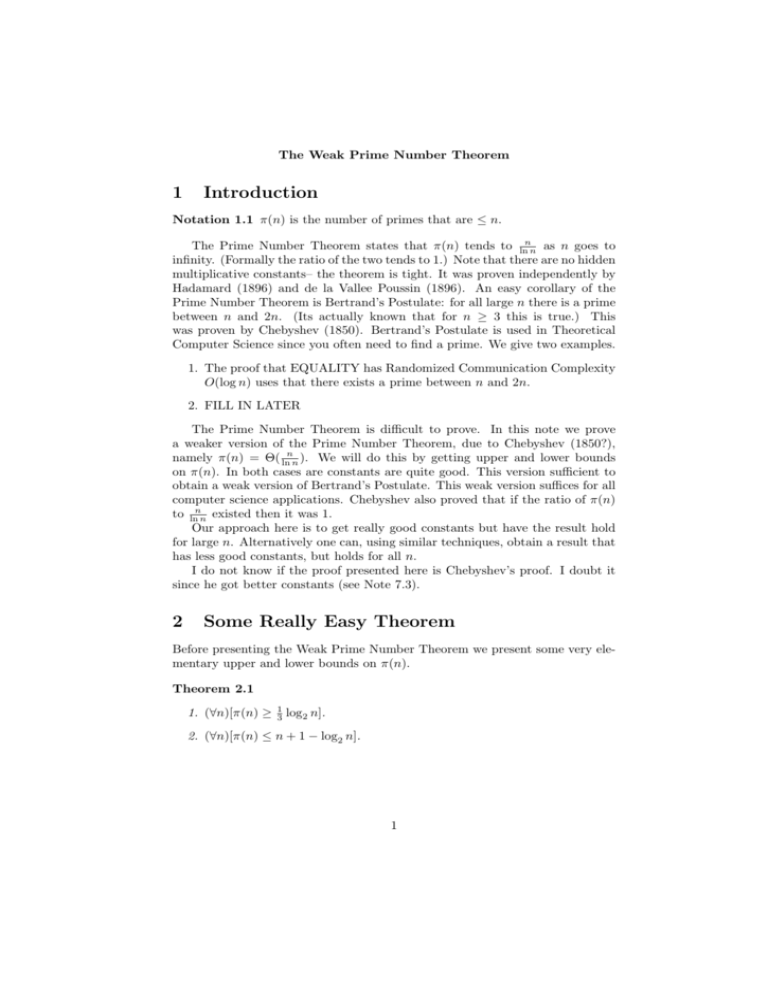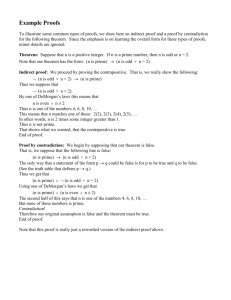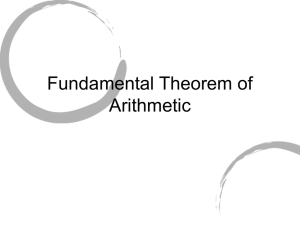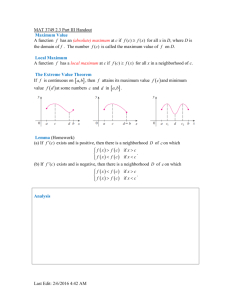1 Introduction 2 Some Really Easy Theorem
advertisement

The Weak Prime Number Theorem
1
Introduction
Notation 1.1 π(n) is the number of primes that are ≤ n.
The Prime Number Theorem states that π(n) tends to lnnn as n goes to
infinity. (Formally the ratio of the two tends to 1.) Note that there are no hidden
multiplicative constants– the theorem is tight. It was proven independently by
Hadamard (1896) and de la Vallee Poussin (1896). An easy corollary of the
Prime Number Theorem is Bertrand’s Postulate: for all large n there is a prime
between n and 2n. (Its actually known that for n ≥ 3 this is true.) This
was proven by Chebyshev (1850). Bertrand’s Postulate is used in Theoretical
Computer Science since you often need to find a prime. We give two examples.
1. The proof that EQUALITY has Randomized Communication Complexity
O(log n) uses that there exists a prime between n and 2n.
2. FILL IN LATER
The Prime Number Theorem is difficult to prove. In this note we prove
a weaker version of the Prime Number Theorem, due to Chebyshev (1850?),
namely π(n) = Θ( lnnn ). We will do this by getting upper and lower bounds
on π(n). In both cases are constants are quite good. This version sufficient to
obtain a weak version of Bertrand’s Postulate. This weak version suffices for all
computer science applications. Chebyshev also proved that if the ratio of π(n)
to lnnn existed then it was 1.
Our approach here is to get really good constants but have the result hold
for large n. Alternatively one can, using similar techniques, obtain a result that
has less good constants, but holds for all n.
I do not know if the proof presented here is Chebyshev’s proof. I doubt it
since he got better constants (see Note 7.3).
2
Some Really Easy Theorem
Before presenting the Weak Prime Number Theorem we present some very elementary upper and lower bounds on π(n).
Theorem 2.1
1. (∀n)[π(n) ≥
1
3
log2 n].
2. (∀n)[π(n) ≤ n + 1 − log2 n].
1
Proof:
Let COM P be the number of composite numbers that are ≤ n.
a) Let x ∈ COM P and x ≤ n. We factor x so that x = pa1 1 · · · paanπ (n) . Write each
2b
c
π(n)
π(n) c1 c2
1 2p2 2b3
ai = 2bi + ci where ci ∈ {0, 1}. Hence x = p2b
1 p2 p3 · · · pπ(n)) p1 p2 · · · pπ(n) .
c
π(n)
. How many numbers are of
Note that this can be written as m2 pc11 pc22 · · · pπ(n)
this form?
√
There are at most n numbers of the form m2 where m2 ≤ n. There are at
cπ(n)
where each ci ∈ {0, 1}. Hence
most 2π(n) numbers of the form pc11 pc22 · · · pπ(n)
there
√ π(n)
COM P ≤
n2
√ π(n)
n − π(n) ≤
n2
√ π(n)
n≤
n2
+ π(n)
if π(n) ≤ ( 31 ) log2 n then
n≤
√
n2π(n) + π(n) ≤
√
nn1/3 +
1
1
log2 n ≤ n5/6 + log2 n
3
3
which is a contradiction.
b) Since 22 , 23 , . . . , 2log2 n are all composite numbers that are less than n we
have
COM P ≥ (log2 n) − 1
n − π(n) ≥ (log2 n) − 1
π(n) ≤ n + 1 − log2 n
EXERCISE: Improve the constants in the above theorem.
3
Definitions
Convention 3.1 Henceforth p will always denote a prime. Throughout this
paper log means log2 unless otherwise noted.
P
Note that π(n) = p≤n 1. This is hard to prove things about. Hence we
consider the following two functions.
Def 3.2
1. f (n) =
P
2. g(n) =
P
p≤n
k≥1
log p.
P
pk ≤n
log p.
We will obtain upper and lower bounds on π(n) in terms of f (n). Then we
will obtain upper and lower bounds on f (n). The lower bound on f (n) will use
g(n).
2
4
Bounds on π(n) in terms of f (n)
f (n)
log n
Lemma 4.1
Proof:
f (n) =
≤ π(n).
P
p≤n
log p ≤ π(n) log n. Hence
Lemma 4.2 Let 0 < δ < 1. Then π(n) ≤
f (n)
δ log n
f (n)
log n
≤ π(n).
+ nδ .
Proof:
f (n) =
X
p≤n
So
f (n)
δ log n
X
log p ≥
log p ≥ (π(n) − π(nδ ) log nδ ≥ (π(n) − nδ )δ log n.
nδ ≤p≤n
≥ π(n) − nδ . Hence π(n) ≤
f (n)
δ log n
+ nδ .
Note 4.3 By Lemmas 4.1 and 4.2 we need only show that f (n) = Θ(n) to
obtain the Weak Prime Number Theorem.
5
Upper Bound on f (n)
Lemma 5.1 f (n) ≤ 2n.
Proof:
We obtain a recurrence for f .
P
P
P
f (2n) = p≤2n log p =
p + n+1≤p≤2n log p
p≤n log
P
= f (n) + n+1≤p≤2n log p
Q
= f (n) + log( n+1≤p≤2n p).
Q
We seek bounds on n+1≤p≤2n p. KEY IDEA: to bound a number find a
number that
Qit divides.
Clearly n+1≤p≤2n p divides (n + 1)(n + 2) · · · 2n. But this is large. We will
divide (n + 1)(n + 2) · · · 2n by some
Q quantity so that what we have left (a) is
still an integer, and (b) still has n+1≤p≤2n p dividing it.
Q
= 2n
Look at (n+1)(n+2)···2n
n!
n . This is an integer. Since
Q n≤p≤2n p divides
the numerator but is relatively prime to the denominator, n+1≤p≤2n p divides
2n
n . Hence
Q
≤ 2n
n
Qn+1≤p≤2n
≤ 22n
Q n+1≤p≤2n
log( n+1≤p≤2n ) ≤ 2n
Hence
f (2n) ≤ f (n) + 2n.
3
Note that f (2n − 1) = f (2n) so we have
f (2n − 1) ≤ f (n) + 2n.
These two equation together easily yields f (n) ≤ 2n.
6
Lower Bounds on f (n)
To obtain lower bounds on f (n) we first need to relate g(n) to f (n) and then
get lower bounds on g(n).
√
Lemma 6.1 g(n) ≤ f (n) + 2 n log n.
P
P
Proof:
g(n) = k≥1 pk ≤n log p.
Let 1 ≤ p ≤ n. How many times is log p a summand? Since p1 ≤ n, at
least once. If p2 ≤ n then it will be counted again. Hence, all primes p ≤ n1/2
contribute at least two log p summands. More generally, if p ≤ n1/i then log p
will appear i times as a summand. Hence we obtain
1/log n
g(n) = f (n) + f (n1/2 ) + f (n1/3
).
√ ) + · · · + f (n
n).
By
Lemma
5.1
we get g(n) ≤ f (n) +
So
g(n)
≤
f
(n)
+
(log
n)f
(
√
2 n log n.
We now obtain a lower bound on g(n).
Lemma 6.2 For all > 0 there exists n0 such that (∀n ≥ n0 )[g(n) ≥ (1 − )n].
Proof:
P
P
g(2n) = k≥1 pk ≤2n log p.
Fix p. How many times does log p appear
It will appear
as a summand?
k times where pk ≤ 2n ≤ pk+1 . This is logp 2n times. Hence g(2n) =
P
p≤2n ( logp 2n )(log p).
CLEVER IDEAfind some other quantity that is about the same.
Look at 2n
n . All its prime factors are ≤ 2n.
Notation 6.3 If p, m ∈ N , p ≤ m, and p is prime then let LARDIV
j k jp,mkbe
m
i
the largest i such that p divides m. Note that LARDIVp,m! = m
p + p2 +
j k
m
p3 + · · ·.
2n
n
Let k = LARDIVp,(2n)! −LARDIVp,n!n! = LARDIVp,(2n)! −2LARDIVp,n! .
Qp
= p≤2n pkp
We need to estimate kp .
kp =
∞ X
(2n)
i=1
pi
−2
∞ X
n
i=1
pi
4
=
∞ X
2n
i=1
pi
−2
n
pi
Note that each summand is either 0 or 1. Also note that at most logp (2n)
of the terms are nonzero. Hence kp ≤ logp (2n) .
So
Y
Y
2n
pblogp 2nc
pkp ≤
=
n
p≤2n
p≤2n
2n
By Stirling’s formula n
22n
2n
n ≥ n . Hence we have
2n
= Θ( 2√n ). Let n00 be such that, for all n ≥ n0 ,
Y
22n
pblogp (2n)c .
≤
n
p≤2n
2n − log n ≤
X ( logp (2n) )(log p) = g(2n).
p≤2n
g(2n) ≥ 2n − log n.
Let n000 be the least number bigger than n00 such that (∀n ≥ n0 )[g(2n) ≥
(2 − )n]. Since g(2n − 1) = g(2n), we also have g(2n − 1) ≥ (2 − )n. Let
n0 = 2n000 . We have (∀n ≥ n0 )[g(n) ≥ (2 − )n].
Lemma 6.4 For all > 0 there exists n0 such that (∀n ≥ n0 )[f (n) ≥ (1 − )n].
√
Proof:
By Lemma 6.1 we have f (n) ≥ g(n) − 2 n log n. Let 0 < 0 < . By
Lemma 6.2 we have that there exists n00 such that
(∀n ≥ n0 )[g(n) ≥ (2 − 0 )n
Hence we have
√
f (n) ≥ (2 − 0 )n − 2 n log n.
Let n0 be the least number ≥ n00 such that
√
(∀n ≥ n0 )[(2 − 0 )n − 2 n log n ≥ (2 − )n].
Clearly (∀n ≥ n0 )[f (n) ≥ (2 − )n].
7
The Weak Prime Number Theorem
Theorem 7.1 For all there exists n0 such that
(∀n ≥ n0 )[(1 − )
n
n
≤ π(n) ≤ (2 + )
]
log n
log n
5
Proof:
By Lemma 4.1 we have that
f (n)
log n
≤ π(n). By Lemma 6.4 we have
(∃n00 )(∀n ≥ n00 )[f (n) ≥ (1 − )n].
Hence we have
(∃n00 )(∀n ≥ n00 )[(1 − )
n
≤ π(n)].
log n
By Lemma 4.2 we have that, for any δ with 0 < δ < 1, π(n) ≤
By Lemma 5.1 we have f (n) ≤ 2n. Hence we have
π(n) ≤
Let δ > 0 be such that
2
δ
f (n)
δ log n
+ nδ .
2n
2 n
+ nδ =
+ nδ
δ log n
δ log n
< (2 + ). Let n000 be such that
(∀n ≥ n000 )[
2 n
n
+ nδ ≤ (2 + )
].
δ log n
log n
Let n0 = max{n00 , n000 }. Then, for all n ≥ n0 ,
(1 − )
n
n
≤ π(n) ≤ (2 + )
.
log n
log n
Note 7.2 The real Prime Number Theorem uses ln n instead of log n. To see
n
how the weak one compares, we rewrite it using the fact that log n = ln
ln 2 . We
have
(∀ > 0)(∃n0 )(∀n ≥ n0 )[(1 − )(ln 2)
n
n
≤ π(n) ≤ (2 + )(ln 2)
].
ln n
ln n
Using 0.69 ≤ ln 2 ≤ 0.7.
(∀ > 0)(∃n0 )(∀n ≥ n0 )[0.69
n
n
≤ π(n) ≤ 1.4
.]
ln n
ln n
Note 7.3 Chebyshev obtained
(∀ > 0)(∃n0 )(∀n ≥ n0 )[0.875
n
n
≤ π(n) ≤ 1.125
.
ln n
ln n
EXERCISE: For = 1, 12 , . . . find a value of n0 . Try to make it as small as
possible.
We can now prove a weak version of Bertrand’s Postulate.
Theorem 7.4 There exists n0 such that, for all n ≥ n0 , there is a prime between n and 3n.
6
Proof:
We need to show that π(3n) − π(n) ≥ 1.
By Theorem 7.1 with = 81 we have (∃n0 )(∀n ≥ n0 )[ 87 ) logn n ≤ π(n) ≤
17 n
8 log n ]. Hence
21 n
17 n
n
π(3n) ≥ 21
8 log 3n ≥ 8 log n . and π(n) ≤ 8 log n .
Hence π(3n) − π(n) ≥ 1.
EXERCISE: Prove a tighter version of Bertrand’s postulate using these
methods.
EXERCISE: Using cruder approximations that work for all n, obtain a
weaker version of the Weak Prime Number Theorem that works for all n. (It
will not have an or n0 in it.)
7








